Let’s be honest: winding down in the evening is no longer as simple as it used to be.
After a long day of notifications, deadlines, and mental chaos, we often find ourselves crawling into bed with our minds still spinning. Even when the body is tired, sleep doesn’t come easy. And if it does, it’s shallow, restless, and anything but rejuvenating.
That’s where evening relaxation techniques for better sleep come in. These aren’t fancy hacks or complicated routines. Instead, they are simple, repeatable habits that signal to your brain: “It’s safe to rest now.”
This post will walk you through the most effective ways to let go of the day and fall into deep, peaceful sleep—naturally.
Why Evening Relaxation Matters
Sleep isn’t just a switch you flip. It’s a transition your body and mind must prepare for.
When you’re constantly exposed to stress, blue light, and hyper-stimulation, your nervous system stays in “fight or flight” mode—even when it’s time to rest. That’s why even a small argument, an intense movie, or one last scroll on social media can steal hours of sleep.
Evening relaxation rituals help guide your body into “rest and digest” mode. They quiet the mental chatter, ease physical tension, and gently tell your system that the day is done.
The result? You don’t just fall asleep faster—you stay asleep longer and wake up genuinely refreshed
Creating a Sleep-Friendly Environment
Before we dive into techniques, let’s talk about the space around you. Your sleep environment plays a huge role in how deeply you rest. Here’s how to make your bedroom a sanctuary of calm.
1. Dim the Lights
Bright lights confuse your body into thinking it’s still daytime. Start dimming the lights an hour before bed. Use lamps instead of ceiling lights, and switch to warm-toned bulbs if you can.
2. Cool Down the Room
Experts agree: the ideal sleeping temperature is between 60–67°F (15–19°C). A slightly cool room tells your body it’s time to slow down and sleep.
3. Block Out Distractions
Noise, light, and screens are sleep’s worst enemies. Try blackout curtains, white noise machines, or sleep masks. If your phone is nearby, turn off notifications—or better yet, leave it in another room.
4. Add Calming Scents
Aromatherapy isn’t just trendy—it’s proven. Lavender, chamomile, and sandalwood all help reduce anxiety and promote deeper sleep. Use essential oil diffusers or pillow sprays as part of your nightly ritual.
Here’s a quick table summarizing how to Seth the scene for sleep:
| Element | Sleep-Friendly Option | Why It Works |
| Lighting | Dim, warm-toned bulbs | Promotes melatonin production |
| Temperature | 60–67°F (15–19°C) | Aligns with natural sleep rhythms |
| Sound | White noise or soft ambient | Masks sudden noise disruptions |
| Scent | Lavender or chamomile | Lowers stress hormones, calms the mind |
| Screens | Avoid 1 hour before bed | Reduces blue light exposure and mental stimulation |
Gentle Body-Based Relaxation Techniques
Physical tension can keep your body in “on” mode even when you want to sleep. These simple body-based techniques help release stress from your muscles and ground you back in the present moment.
Gentle Stretching or Bedtime Yoga
You don’t need a full workout. A few slow stretches before bed can do wonders. Focus on releasing your back, hips, shoulders, and neck—where most of us carry tension.
Try this simple flow:
- Forward fold (releases hamstrings and spine)
- Child’s pose (relieves back and hips)
- Seated twist (loosens spine)
- Legs-up-the-wall pose (drains tension from legs)
Just five to ten minutes can physically signal your nervous system to unwind.
Progressive Muscle Relaxation (PMR)
This is one of the most effective evening relaxation techniques for better sleep, especially if you feel anxious or restless.
Here’s how it works:
- Lie down comfortably.
- Start at your feet and work up to your head.
- Tense one muscle group (e.g., calves) for 5 seconds.
- Release completely for 10 seconds and feel the tension melt.
- Move to the next area (e.g., thighs, then abdomen).
This technique not only relaxes your body—it pulls your attention away from spiralling thoughts and into sensation
Breathwork That Calms The Nervous System

Your breath is the remote control to your nervous system.
When your breathing is shallow and fast, your brain stays in alert mode. But when you slow it down, lengthen the exhale, and deepen the rhythm, your body automatically relaxes.
Here are two powerful breathing techniques for your evening wind-down:
4-7-8 Breathing Technique
This method works like a natural tranquilizer.
- Inhale for 4 counts
- Hold the breath for 7 counts
- Exhale slowly for 8 counts
- Repeat for 4–8 rounds
You’ll notice your heart rate slowing and your muscles softening after just a few cycles.
Box Breathing (Square Breathing)
This is a great option if your mind is busy or overthinking.
- Inhale for 4 counts
- Hold for 4 counts
- Exhale for 4 counts
- Hold again for 4 counts
Repeat this square pattern several times. It creates a rhythmic, meditative effect that quiets mental noise.
Breathing might seem simple—but in the evening, it’s your secret weapon for reclaiming calm
Mindfulness Meditation for Better Sleep
If your brain has trouble letting go of the day, mindfulness meditation is a powerful tool. It’s not about stopping thoughts—it’s about observing them without judgment and allowing them to pass like clouds.
Here’s how to try it:
- Sit or lie comfortably.
- Focus on your breath, body, or a calming sound.
- When thoughts arise (they will), gently return to your anchor.
Even 5–10 minutes before bed can reduce stress, quiet mental chatter, and shift your brainwaves toward sleep mode.
You can also use guided meditations from apps like:
- Calm (soothing voice and sleep stories)
- Insight Timer (huge free library)
- Headspace (great for beginners)
Over time, this becomes a soothing habit that your body starts to associate with sleep.
Journaling as a Mental Cleanse
Have you ever laid in bed thinking about everything you didn’t do today or everything you have to do tomorrow? That mental to-do list is one of the biggest blocks to falling asleep. Writing it out helps.
Try one (or both) of these:
- Brain Dump: Write every worry, task, or thought buzzing in your head. Don’t organize it—just empty it out.
- Gratitude List: Jot down 3 things you’re thankful for from today. This small shift in mindset helps create a sense of peace and closure to the day.
Journaling turns internal chaos into external clarity. It doesn’t solve your problems—but it gives your brain permission to rest.
The Power of Touch and Stillness
Touch and stillness can greatly support better sleep. Gentle physical contact—like cuddling a partner or self-massage—reduces stress and promotes relaxation through hormones like oxytocin. Equally, quiet moments of stillness, such as sitting silently or enjoying tea, help calm the mind and body before bed.
Sound as a Sleep Signal
Sound isn’t just something you hear—it’s something your nervous system feels. That’s why certain types of audio can instantly shift your body into a state of ease, while others stimulate it.
Here are a few sound-based evening relaxation techniques to explore:
White Noise and Pink Noise
Consistent sounds like white or pink noise can mask disruptions and improve sleep. Pink noise, with its natural rhythm, is especially effective in enhancing deep sleep by syncing brain waves.
Ambient and Binaural Music
Slow instrumental music and binaural beats can promote relaxation by slowing heart rate and syncing brainwaves. Ideal playlists include soft piano, nature sounds, and gentle ambient tones without lyrics or abrupt changes.
ASMR (Autonomous Sensory Meridian Response)
While not for everyone, ASMR videos or sounds—like soft whispers, tapping, or page-turning—can relax your mind deeply. They may trigger a tingling sensation or simply induce calm.
The key is consistency. Over time, these sounds become part of your “sleep cue system.”
Digital Detox: Unplug to Unwind
Evening screen use can significantly disrupt sleep by suppressing melatonin due to blue light exposure and overstimulating the brain through scrolling or binge-watching. To improve sleep, aim to turn off screens at least 60 minutes before bed (or start with 30 and build up). If you must use devices, switch on night mode or use blue light-reducing apps like f.lux. Keeping your phone out of reach—or outside the bedroom entirely—can also help reduce temptation and promote a more restful environment.
Creative and Mindful Evening Rituals
Sleep is a deeply personal experience, so your wind-down ritual should be, too. Adding a creative or reflective element to your evenings can anchor your nervous system in the present and help mark the transition from day to night.
Try These:
1. Colouring Books
This surprisingly soothing activity reduces stress by encouraging focus and repetitive motion.
2. Gentle Crafting
Knitting, simple embroidery, or even clay sculpting can calm your mind without requiring much thinking.
3. Music Appreciation
Put on an instrumental playlist, light a candle, and do nothing but listen. Let your thoughts wander without judgment.
4. Candle Gazing (Trataka)
This yogic meditation involves simply staring at a candle flame in a dark room. It slows brain activity and quiets mental restlessness.
45-Minute Evening Wind-Down Routine
Let’s bring it all together. Here’s a sample routine combining several of the techniques we’ve discussed. You can adapt this based on your time, energy level, or preferences.
| Time | Activity | Purpose |
| 9:00 PM | Dim lights, turn on diffuser with lavender oil | Start sensory signals for sleep |
| 9:10 PM | Light stretches and breathing (4-7-8) | Release tension, shift to calm |
| 9:20 PM | Journaling (brain dump + gratitude) | Clear mind, cultivate peace |
| 9:30 PM | Fiction reading with herbal tea | Mental transition, reduce stimulation |
| 9:45 PM | Sound therapy or guided meditation | Deepen relaxation and drift off |
Keep in mind that the goal isn’t perfection—it’s consistency. Even if you follow half of this on most nights, your sleep will begin to improve.
Mistakes That Can Disrupt Evening Relaxation

Some common evening habits can unknowingly interfere with good sleep.
Eating heavy or spicy meals too late forces your digestive system to stay active—aim to finish eating 2–3 hours before bed.
Working into the evening, even something as simple as checking one last email, can trigger stress and make it harder to wind down, so it’s important to set clear work boundaries after dinner.
Watching intense or emotional shows can raise adrenaline levels, delaying relaxation; save those for earlier in the day.
Caffeine, even in the afternoon, can linger in your system for hours—switch to calming herbal teas like chamomile, lemon balm, or passionflower.
Lastly, while short naps can be restorative, napping too late or too long (over 30 minutes) can reduce your natural sleep drive, so keep them early and brief.
When Sleep Still Feels Elusive
If you’ve built a calming evening routine and still struggle with falling or staying asleep, it might be time to look deeper.
Here are some signs you should seek professional support:
- You lie awake for more than 30–45 minutes nightly.
- You wake up multiple times without reason.
- You feel exhausted even after 7–8 hours in bed.
- You rely on sleep aids regularly to fall asleep.
In such cases, consult a sleep specialist or consider Cognitive Behavioral Therapy for Insomnia (CBT-i)—a proven, non-drug approach to restoring natural sleep patterns.
My Opinion
Sleep isn’t just about what happens in bed—it’s shaped by the hours leading up to it. The beauty of evening relaxation lies in its simplicity. Whether it’s a few deep breaths, a warm cup of tea, or the scent of lavender in the air, these small rituals accumulate to create big changes in how you rest.
Start slow. Choose one or two techniques that resonate with you and make them your own. Over time, they’ll evolve into non-negotiable habits that guide you gently into the sleep your mind and body have been craving all along.



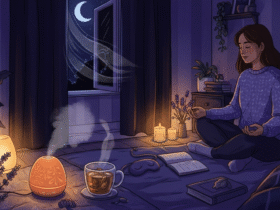

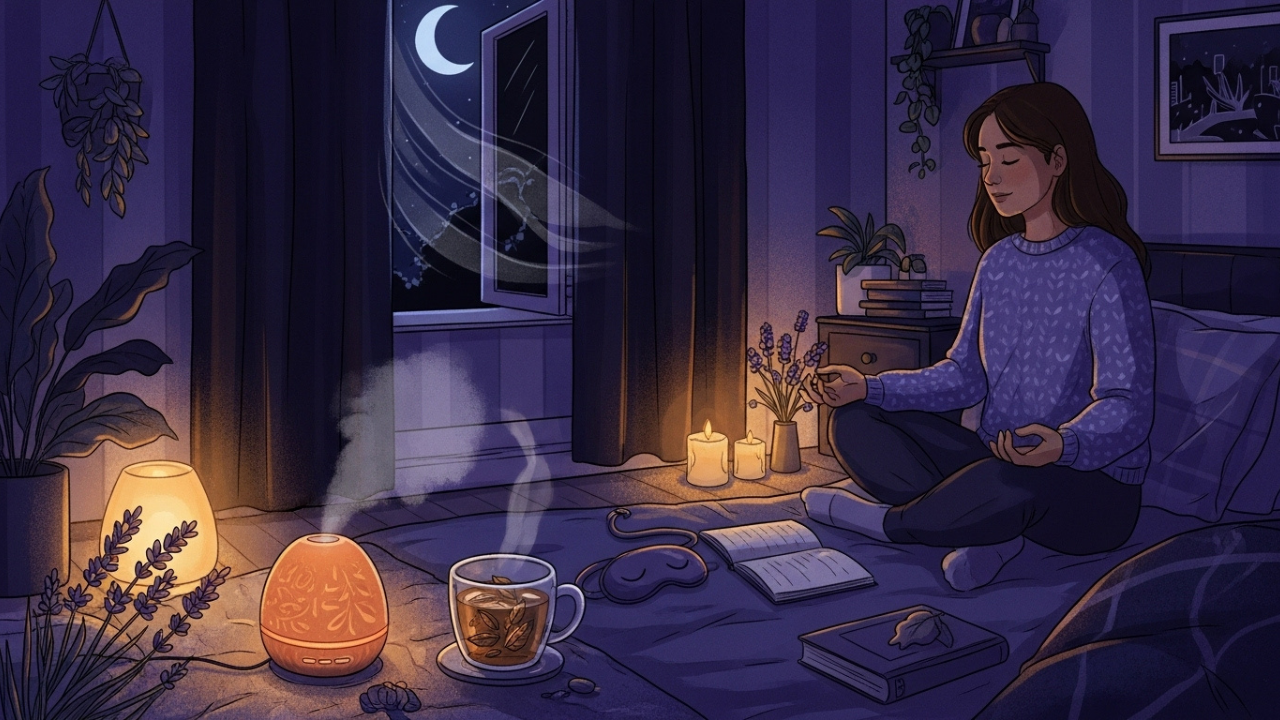



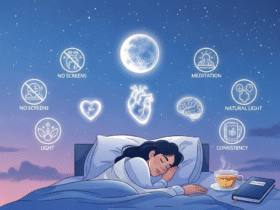
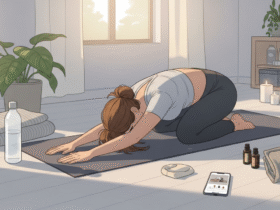

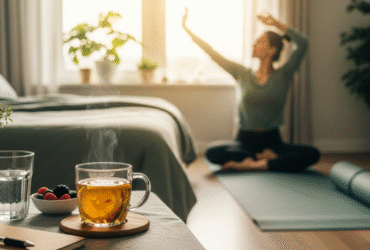
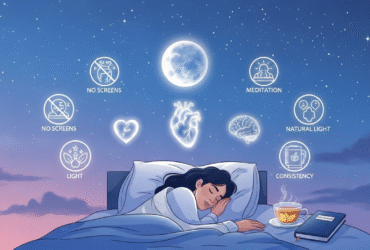
Leave a Reply